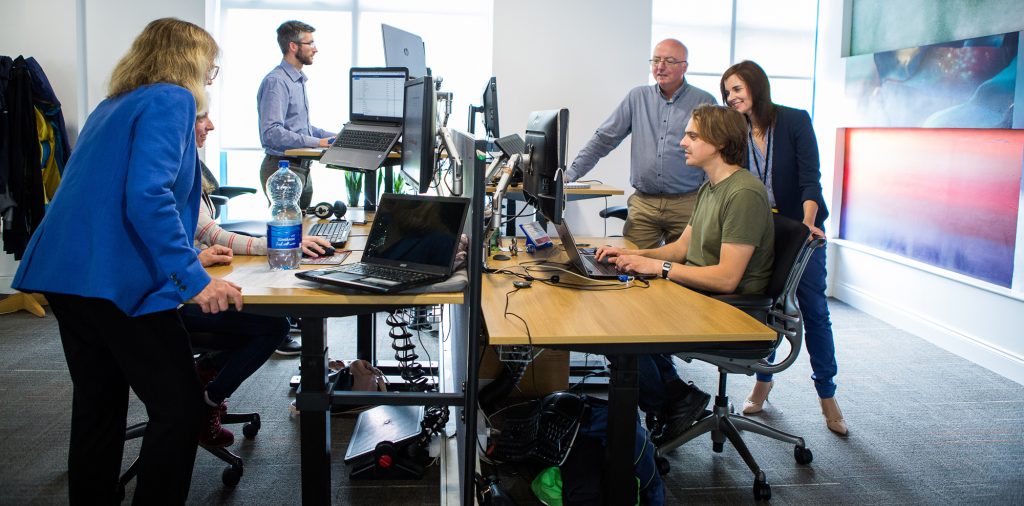The evidence for and against sit-stand desks
First published in Health and Safety at Work Magazine, June 2016
Are stand-sit desks the solution to sedentary lifestyles?
The dangers of a sedentary lifestyle are well known, but for office workers, who traditionally sit too much, is standing at their desks really the answer? There is plenty of evidence that prolonged standing is also bad for you. For example, Waters and Dick draw together evidence in Rehabilitation Nursing (2015) showing that prolonged standing is associated with lower back pain, sore feet, swollen legs, stiff necks, cardiovascular problems and varicose veins, while an advice sheet from the Royal College of Physicians says there is a small increase in the risk of miscarriage, pre-term birth or low birth weight for pregnant women who are standing for more than six hours a day.
So before we decide to lead office staff into a world more familiar to hairdressers, shop assistants and factory workers, we should stop and consider what what stand-sit and stand-biased desks (see box below) are trying to achieve and the evidence for their efficacy.

Free choice
If you cherry pick the research, you can find results that initially sound convincing. A study from the Japanese National Institute of Health and Nutrition in Tokyo (Miyachi et al, 2015) and published in BMC Public Health showed an increase in physical activity, as measured by accelerometers, when workers had access to standing desks. The standing desks were shared between workers and required them to walk to a different part of the office to use them. Though the abstract claims that the time spent in physical activity was “significantly higher” during the standing phase than in the control period, the differences remain unpersuasive. “Moderate” and “moderate to vigorous” physical activity increased from 110 minutes a day in the control period to 121 minutes a day in the standing phase. This difference is statistically significant but 11 minutes a day is not going to stop a coronary. Consider too that the Japanese workers were instructed to spend ten hours a week at the standing desks, and did so.
Other studies give workers a free choice of sitting and standing, and then ask whether stand-sit or stand-biased desks encourage people to stand more. The unsurprising answer is “yes”; some people will stand more of the time if you provide them with a desk that allows them to stand. Even this evidence isn’t overwhelming, however.
A Cochrane review by Shrestha et al (2016) set out to “evaluate the effects of workplace interventions to reduce sitting at work compared to no intervention or alternative interventions”. It found that supplying sit-stand desks as the only intervention, or supplying them with some counselling and information, compared with no intervention, did lead people to spend less time sitting, as measured at three months and six months. The amount of extra standing on its own, however, does not reach the activity levels recommended for good health. Shrestha et al conclude: “Sit-stand desks did not have a considerable effect on work performance, musculoskeletal symptoms or sick leave. It remains unclear if standing can repair the harms of sitting because there is hardly any extra energy expenditure.”
Stand to attention
There are two types of desks available to encourage standing. The most well-known approach is the “stand-sit” desk, where the height can be altered, either mechanically (for example, with a wind-up handle) or electrically at the press of a button, to adjust from a sitting to a standing position. The research on standing also considers “stand-biased” desks, a cheaper alternative that make use of a desk fixed at standing height, but which can also be used for sitting by providing a high stool. Much of the research on stand-biased desks is based in schools, though they are also sometimes used in workplace meeting areas to allow people to choose whether to sit or stand with their colleagues.
Given the choice of standing or sitting, many will sit all day.

Counting calories
Another line of thinking is that if you burn more calories standing than sitting then this must be a good thing. But how many more calories do you use with the alternative desks? A study published in 2011 in the American Journal of Public Health by Benden et al looked at calorie use in six and seven year olds provided with stand-biased desks and stools. Three months into the study, usage was high: 70% of students stood 100% of the time they were using the stand-biased classroom, and the remaining 30% were standing, on average, 75% of the time. They didn’t record how many six year olds fell off the high stools, but they did measure calorie use with an armband device.
Children with access to the standing desks burned 17% more calories on average than the control group, and when looking at just those children already at the heavy end of the weight scale, they burned 32% more calories. While these figures initially sound quite impressive, the sample size was small (31 children in the standing group), and the allocation process had resulted in an average 4% greater weight in the standing group compared with the control group – heavier people use more calories to do the same activity. The important question unanswered in this paper is whether an increase in calorie expenditure from 63kcal per hour to 73kcal per hour makes a significant difference.
In 2014 Benden and other colleagues published a larger study of more than 300 slightly older children (mean age 8.5 years) in the International Journal of Environmental Research and Public Health. Though statistically significant results were found between the control and standing groups, the number of additional calories expended was still small at fewer than 10kcal an hour in the first term, falling to fewer than 5kcal per hour in the second term. Increasing calorie expenditure by 80kcal (equivalent to a large apple or a small banana) by standing for an eight hour day doesn’t sound like much of a contribution to an obesity epidemic.
In 2000, the US Department of Health and Human Services set a target to get back to 1970s levels of obesity (around 5%) by 2010. This was not met, and a paper published in the American Journal of Preventive Medicine in 2012 by Wang et al calculated that to meet the targets by 2020 would require an average change in the gap between calorie intake and expenditure of 177kcal per day for those aged 12–19. As the gap widens with age, it’s a reasonable assumption that, if obesity is the issue, adult workers will need a greater benefit from standing at work than 80kcal a day to make it worthwhile.
Taking the strain
Not everyone who considers standing for work is thinking about calories and obesity. Sitting for prolonged periods is also associated with musculoskeletal problems, in particular neck, back, shoulder and wrist pain. So, can standing really help? Or are we just substituting one type of strain on the body for another? The 2016 Cochrane review found mixed results for the effect of stand-sit desks on musculoskeletal discomfort. Some studies showed more discomfort, some less and others no change as a result of standing more.
Another BMC Public Health paper by Graves et al (2015) considers the more general health benefits of standing versus sitting. They refer to research on the problems of sedentary lifestyles generally (including obesity, insulin resistance, cardiovascular disease, and chronic back and neck pain) as evidence that sitting at work is itself damaging. But whether people who sit at work and exercise in their leisure time are healthier than those who stand still at work and flop on sofas at home is not considered.
Graves et al compared a group provided with stand-sit workstations, initial training and online support with a control group over an eight week period, and found, unsurprisingly, that there was an increase in time spent standing in the study group. They also found improvements in diastolic blood pressure, FMD (flow-mediated dilation, which measures the propensity for heart attacks and strokes), cholesterol levels and musculoskeletal discomfort. None of these improvements, however, reached a level of statistical significance. Interestingly, the musculoskeletal benefit was mostly in the upper back, with no differences for the lower back, and a limited benefit for neck and shoulders. Since measures of discomfort were self-reported, it is not clear how much of this was a Hawthorne effect (people reporting a benefit because they have been given something new).
Mental agility
Employers often fear that standing at a desk will make it more difficult to concentrate on work. On the other hand, some organisations promoting stand-sit desks claim that standing actually enhances mental performance. In the Graves et al study, participants generally did not think their productivity was greatly reduced. A study in an Australian telecoms call-centre by Chau, Sukala et al, published in Preventive Medicine Reports in 2015, measured productivity more objectively by comparing a control group with a group provided with a sit-stand desk, brief training and daily email reminders to stand more. After one week, the control group was sitting for 64 minutes a day less on average, and by 19 weeks by 100 minutes a day less. Productivity measures (hold time, talking time, call handling time and absenteeism) remained unchanged from baseline measurements during the study period.
Call centre work, however, tends to follow a script, so employers might still be concerned as to whether creative tasks are affected. Evidence on this is more difficult to find and a lot of work has focused on school children. The name Benden, author of the studies on primary-age students, appears again in a study by Mehta, Shortz and Benden in the International Journal of Environmental Research and Public Health in 2015, which looks at “the neurocognitive benefits of stand-biased school desks.” Though the abstract states that “continued utilisation of the stand-biased desks was associated with significant improvements in executive function and working memory capabilities”, closer examination undermines this.
The researchers carried out several performance tests, finding improvements in some and no change in others. Since there was no control group, it is impossible to say whether the improvement from the start to the end of the study was due to standing or to greater familiarity with the tests on repetition. A more recent, randomised control trial published in Human Factors (Bantoft et al, 2016) found the best that can be said of standing while working is that “cognitive performance is not degraded”.
Interrupting sitting
Research in the Journal of Science and Medicine in Sport in 2015 by Bailey and Locke suggests that some of the benefits claimed for “increased activity” will only be apparent if you interrupt sitting with walking, and that simply standing will not have the same benefits.
The 2016 Cochrane review by Shrestha et al looked for studies on the effect of “active workstations”. They found low quality evidence and inconsistent results. Considering the expense involved in supplying such equipment, the average reduction in sitting in a study of “treadmill” desks was less than half an hour a day, and just 12 minutes a day for a “pedalling workstation”. Getting people to go for a walk at lunch time would be more effective.
Other methods of promoting greater activity, such as providing software on computers that reminds users to stretch or stand up, might be more cost effective than new desks. The 2016 Cochrane review reports on two studies that looked at software activity prompts, which found a decrease in mean sitting time at work of up to an hour per day. Activity software also has benefits for eye fatigue and headaches.
A study in Trials by Júdice et al (2015) used screen alerts to prompt overweight and obese workers to walk and to encourage greater activity when not at work. They did not provide any stand-sit or stand-biased desks but nevertheless found reductions in sitting time comparable with those in studies which did provide desks. Similarly, a study of university staff by Mackenzie et al in BMC Public Health (2015) showed that screen-delivered reminders to exercise, emails suggesting ideas such as standing meetings, along with signs beside lifts recommending the use of stairs, produced reductions in sitting time at least as much as stand-sit desks.
The approach in the Japanese accelerometer study mentioned at the beginning of the article (Miyachi et al 2015) had several advantages. First, by providing standing desks as “hot desks”, an organisation does not need to invest as much as it would in providing each worker with an adjustable desk. Second, since other research suggests walking is more important than standing, moving between a sitting area and a standing area can provide additional opportunities for exercise. You could start, for example, by providing stand-sit desks for a meeting area and then assess the uptake.
What is clear is that the core issue is not just about standing or sitting. What we should be trying to achieve is that people do not simply substitute sitting in one place with standing in one place but, once standing, they become more active overall. This is reflected in a comment in a qualitative study by Grunseit et al (2013) published in BMC Public Health: “I do tend to move around my office a lot more as well. So I will go over and get something … whereas if you have to get up and walk away from your chair, I’m probably less likely to do it. I’ll save it as a group of things so I’ll only have to go down once.”
A final thought is that if you do decide to encourage workers to stand more at work, you might need to rethink floor surfaces, and staff might need to reconsider their footwear.
